Vehicle Emission Changes in China under Different Control Measures over Past Two Decades
Abstract
1. Introduction
2. Materials and Methods
2.1. Calculation of Emission Inventory
2.2. Emission Factors
2.3. Vehicle Ownership
2.4. VKT Evolution Trend
3. Results and Discussions
3.1. Vehicle Ownership and Emission Inventory
3.1.1. Evolution Trend of Vehicle Ownership
3.1.2. Emission Inventories
3.1.3. Contributions of Different Vehicles
3.2. Evaluation of Emission Reduction Effects
3.2.1. Eliminating High-Emission Vehicles
3.2.2. Improving Emission and Fuel Standards
3.2.3. Regulating and Controlling of PCs
3.2.4. Comparison of Different Control Measures
4. Conclusions
Author Contributions
Funding
Institutional Review Board Statement
Informed Consent Statement
Data Availability Statement
Conflicts of Interest
References
- Cao, X.N.; Shen, L.J.; Wu, S.D.; Yan, C.; Zhou, Y.; Xiong, G.; Wang, Y.C.; Liu, Y.; Liu, B.; Tang, X.L. Urban fine particulate matter exposure causes male reproductive injury through destroying blood-testis barrier (BTB) integrity. Toxicol. Lett. 2017, 266, 1–12. [Google Scholar] [CrossRef] [PubMed]
- Yao, Z.; Huo, H.; Zhang, Q.; Streets, D.G.; He, K. Gaseous and particulate emissions from rural vehicles in China. Atmos. Environ. 2011, 45, 3055–3061. [Google Scholar] [CrossRef]
- Chen, Z.; Wang, J.N.; Ma, G.X.; Zhang, Y.S. China tackles the health effects of air pollution. Lancet 2013, 382, 1959–1960. [Google Scholar] [CrossRef] [PubMed]
- Ministry of Ecology and Environment. China Mobile Source Environmental Management Annual Report 2020[EB]. Available online: http://www.mee.gov.cn/hjzl/sthjzk/ydyhjgl/202008/P020200811521365906550.pdf (accessed on 11 July 2022).
- Derwent, R.G.; Jenkin, M.E.; Utembe, S.R.; Shallcross, D.E.; Murrells, T.P.; Passant, N.R. Secondary organic aerosol formation from a large number of reactive man-made organic compounds. Sci. Total Environ. 2010, 408, 3374–3381. [Google Scholar] [CrossRef]
- Liu, T.; Wang, X.; Deng, W.; Hu, Q.; Ding, X.; Zhang, Y.; He, Q.; Zhang, Z.; Lü, S.; Bi, X. Secondary organic aerosol formation from photochemical aging of light-duty gasoline vehicle exhausts in a smog chamber. Atmos. Chem. Phys. 2015, 15, 9049–9062. [Google Scholar] [CrossRef]
- Gordon, T.D.; Presto, A.A.; May, A.A.; Nguyen, N.T.; Robinson, A.L. Secondary organic aerosol formation exceeds primary particulate matter emissions for light-duty gasoline vehicles. Atmos. Chem. Phys. 2014, 14, 23173–23216. [Google Scholar] [CrossRef]
- Lang, J.; Cheng, S.; Zhou, Y.; Zhang, Y.; Wang, G. Air pollutant emissions from on-road vehicles in China, 1999–2011. Sci. Total Environ. 2014, 496, 1–10. [Google Scholar] [CrossRef]
- Gong, M.; Yin, S.; Gu, X.; Xu, Y.; Jiang, N.; Zhang, R. Refined 2013-based vehicle emission inventory and its spatial and temporal characteristics in Zhengzhou, China. Sci. Total Environ. 2017, 599–600, 1149–1159. [Google Scholar] [CrossRef]
- Zheng, X.; Wu, Y.; Zhang, S.; Hu, J.; Zhang, K.M.; Li, Z.; He, L.; Hao, J. Characterizing particulate polycyclic aromatic hydrocarbon emissions from diesel vehicles using a portable emissions measurement system. Sci. Rep. 2017, 7, 10058. [Google Scholar] [CrossRef]
- Li, L.; Xie, S.; Zeng, L.; Wu, R.; Jing, L. Characteristics of volatile organic compounds and their role in ground-level ozone formation in the Beijing-Tianjin-Hebei region, China. Atmos. Environ. 2015, 113, 247–254. [Google Scholar] [CrossRef]
- Nam, K.; Zhang, X.; Zhong, M.; Saikawa, E.; Zhang, X. Health effects of ozone and particulate matter pollution in China: A province-level CGE analysis. Ann. Reg. Sci. 2019, 63, 269–293. [Google Scholar] [CrossRef]
- Chen, Z.; Cui, L.; Cui, X.; Li, X.; Yu, K.; Yue, K.; Dai, Z.; Zhou, J.; Jia, G.; Zhang, J. The association between high ambient air pollution exposure and respiratory health of young children: A cross sectional study in Jinan, China. Sci. Total Environ. 2019, 656, 740–749. [Google Scholar] [CrossRef]
- Fuinhas, J.A.; Koengkan, M.; Leito, N.C.; Nwani, C.; Uzuner, G.; Dehdar, F.; Relva, S.; Peyerl, D. Effect of Battery Electric Vehicles on Greenhouse Gas Emissions in 29 European Union Countries. Sustainability 2021, 13, 13611. [Google Scholar] [CrossRef]
- Wang, M.; Li, T.F.; Yuan, C.; Tian, H.; Tian, S. Research on vehicle renewable energy use in cities with different carbon emission characteristics. Energy Rep. 2022, 8, 343–352. [Google Scholar] [CrossRef]
- Yanowitz, J.; Mccormick, R.L.; Graboski, M.S. In-Use Emissions from Heavy-Duty Diesel Vehicles. Environ. Sci. Technol. 2016, 34, 729–740. [Google Scholar] [CrossRef]
- Kousoulidou, M.; Fontaras, G.; Ntziachristos, L.; Bonnel, P.; Samaras, Z.; Dilara, P. Use of portable emissions measurement system (PEMS) for the development and validation of passenger car emission factors. Atmos. Environ. 2013, 64, 329–338. [Google Scholar] [CrossRef]
- Iqbal, A.; Allan, A. On-Road Vehicular Emission Inventory in View of Its Distribution Over Dhaka City, Bangladesh: A Bottom-Up Modelling Approach to Support Sustainability Assessment. J. Econ. Sustain. Dev. 2014, 5, 34–44. [Google Scholar]
- Sun, S.; Jiang, W.; Gao, W. Vehicle emission trends and spatial distribution in Shandong province, China, from 2000 to 2014. Atmos. Environ. 2016, 147, 190–199. [Google Scholar] [CrossRef]
- Liu, Y.H.; Liao, W.Y.; Lin, X.F.; Li, L.; Zeng, X.L. Assessment of Co-benefits of vehicle emission reduction measures for 2015–2020 in the Pearl River Delta region, China. Environ. Pollut. 2017, 223, 62–72. [Google Scholar] [CrossRef]
- Wang, B.; Liu, Y.; Liao, W.; Li, L.I.; Ding, H.; Chen, J. Assessment of Vehicle Emission Reduction Measures Based on the Analysis of Co-control in the Non-Pearl River Delta Region. Environ. Sci. Technol. 2019, 223, 62–72. [Google Scholar]
- Wang, H.; Fu, L.; Zhou, Y.; Du, X.; Ge, W. Trends in vehicular emissions in China’s mega cities from 1995 to 2005. Environ. Pollut. 2010, 158, 394–400. [Google Scholar] [CrossRef] [PubMed]
- Ye, W.U.; Wang, R.; Zhou, Y.U.; Lin, B.; Lixin, F.U.; Kebin, H.E.; Hao, I. On-road vehicle emission control in Beijing: Past, present, and future. Environ. Sci. Technol. 2011, 45, 147. [Google Scholar]
- Wu, Y.; Yang, Z.D.; Lin, B.H.; Liu, H.; Wang, R.J.; Zhou, B.Y.; Hao, J.M. Energy consumption and CO2 emission impacts of vehicle electrification in three developed regions of China. Energy Policy 2012, 48, 537–550. [Google Scholar] [CrossRef]
- Zhang, Y.; Wu, L.; Zou, C.; Jing, B.Y.; Li, X.Y.; Barlow, T.; Kevin, T.; Andre, M.; Liu, Y.; Ren, P.P.; et al. Development and Application of Urban High Temporal-Spatial Resolution Vehicle Emission Inventory Model and Decision Support System. Environ. Model. Assess. 2017, 22, 445–458. [Google Scholar] [CrossRef]
- Sun, S.; Zhao, G.; Wang, T.; Jin, J.; Wang, P.; Lin, Y.; Li, H.; Ying, Q.; Mao, H. Past and future trends of vehicle emissions in Tianjin, China, from 2000 to 2030. Atmos. Environ. 2019, 209, 182–191. [Google Scholar] [CrossRef]
- Ya-Ling, L.U.; Jia, Z.; Xi, C.; Wei, Z.; Hong-Qiang, J. Emission Reduction Benefits When Eliminating Yellow-label Vehicles in the Jing-jin-ji Region. Environ. Sci. 2018, 39, 2566–2575. [Google Scholar] [CrossRef]
- Xie, P.F.; Tang, D.G.; Zhang, S.Q. Environmental economic analysis of upgrading the fuel quality in the Jing-Jin-Ji region. China Environ. Sci. 2017, 37, 2352–2362. [Google Scholar]
- Yang, W.; Yu, C.; Yuan, W.; Wu, X.; Zhang, W.; Wang, X. High-resolution vehicle emission inventory and emission control policy scenario analysis, a case in the Beijing-Tianjin-Hebei (BTH) region, China. J. Clean. Prod. 2018, 203, 530–539. [Google Scholar] [CrossRef]
- Guo, X.; Fu, L.; Ji, M.; Lang, J.; Chen, D.; Cheng, S. Scenario analysis to vehicular emission reduction in Beijing-Tianjin-Hebei (BTH) region, China. Environ. Pollut. 2016, 216, 470–479. [Google Scholar] [CrossRef]
- Ekstroem, M.; Sjoedin, A.; Andreasson, K. Evaluation of the COPERT III emission model with on-road optical remote sensing measurements. Atmos. Environ. 2004, 38, 6631–6641. [Google Scholar] [CrossRef]
- Gkatzoflias, D.; Kouridis, C.; Ntziachristos, L.; Samaras, Z. COPERT 4: Computer Programme to Calculate Emissions from Road Transport; European Environment Agency: Copenhagen, Denmark, 2006. [Google Scholar]
- Smit, R.; Ntziachristos, L. COPERT Australia: A new software to estimate vehicle emissions in Australia. In Proceedings of the Australasian Transport Research Forum 2013, Brisbane, Australia, 2–4 October 2013. [Google Scholar]
- Lang, J.; Cheng, S.; Wei, W.; Zhou, Y.; Xiao, W.; Chen, D. A study on the trends of vehicular emissions in the Beijing–Tianjin–Hebei (BTH) region, China. Atmos. Environ. 2012, 62, 605–614. [Google Scholar] [CrossRef]
- Sun, S.D.; Sun, L.N.; Liu, G.; Zou, C.; Wang, Y.A.; Wu, L.; Mao, H.J. Developing a vehicle emission inventory with high temporal-spatial resolution in Tianjin, China. Sci. Total Environ. 2021, 776, 145873. [Google Scholar] [CrossRef]
- Association, C.A.I. China Automotive Industry Yearbook; China Automotive Industry Association: Beijing, China, 2020. [Google Scholar]
- Cai, H.; Xie, S. Estimation of vehicular emission inventories in China from 1980 to 2005. Atmos. Environ. 2007, 41, 8963–8979. [Google Scholar] [CrossRef]
- Hong-li, W.; Sheng-ao, J.; Sheng-rong, L.; Qing-yao, H.; Li, L.; Shi-Kang, T.; Cheng, H.; Li-ping, Q.; Chang-hong, C. Volatile organic compounds (VOCs) source profiles of on-road vehicle emissions in China. Sci. Total Environ. 2017, 607, 253–261. [Google Scholar] [CrossRef]
- Qi, L.; Zhao, J.; Li, Q.; Su, S.; Lai, Y.; Deng, F.; Man, H.; Wang, X.; Shen, X.e.; Lin, Y.; et al. Primary organic gas emissions from gasoline vehicles in China: Factors, composition and trends. Environ. Pollut. 2021, 290, 117984. [Google Scholar] [CrossRef]
- Tang, W.; Zheng, S.; Ping, H.E.; Hailan, X.U.; Yu, G.U.; Yan, L.; Yang, Q.; Huang, C.; Shen, Y. Study on the co-benefit of motor vehicle emission control based on scenario analysis in Hangzhou. Acta Sci. Circumstantiae 2019, 39, 2033–2042. [Google Scholar] [CrossRef]
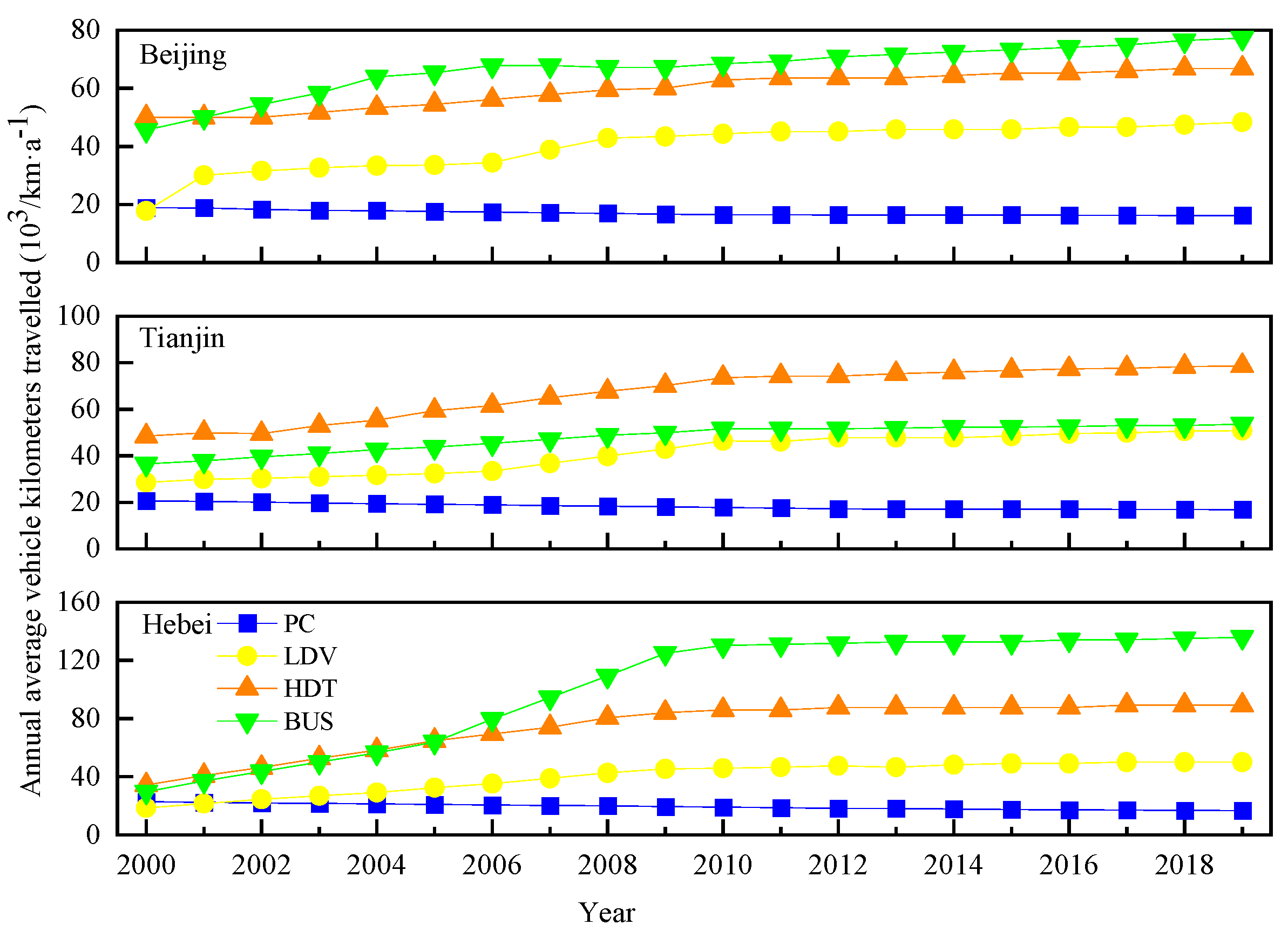
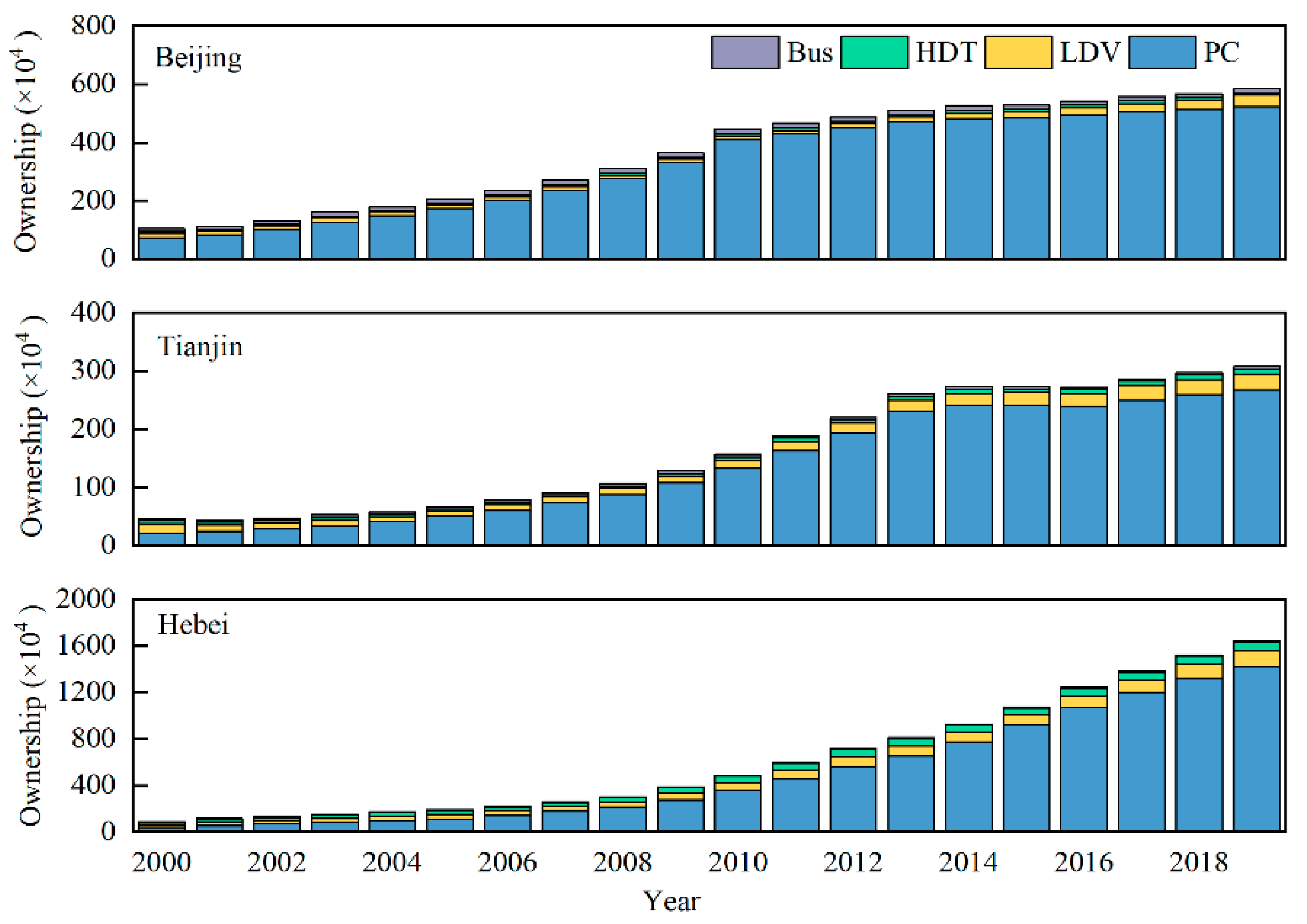
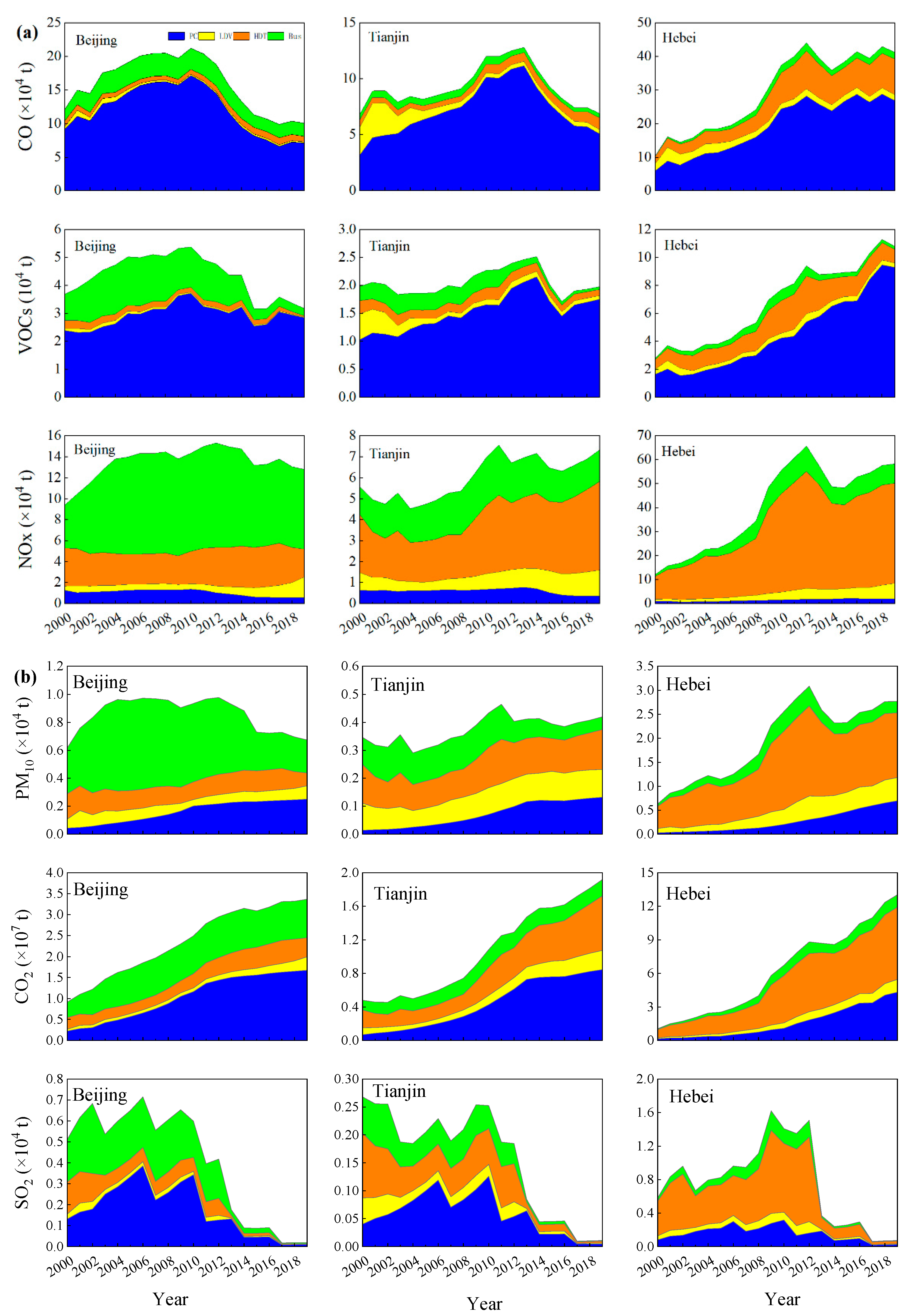

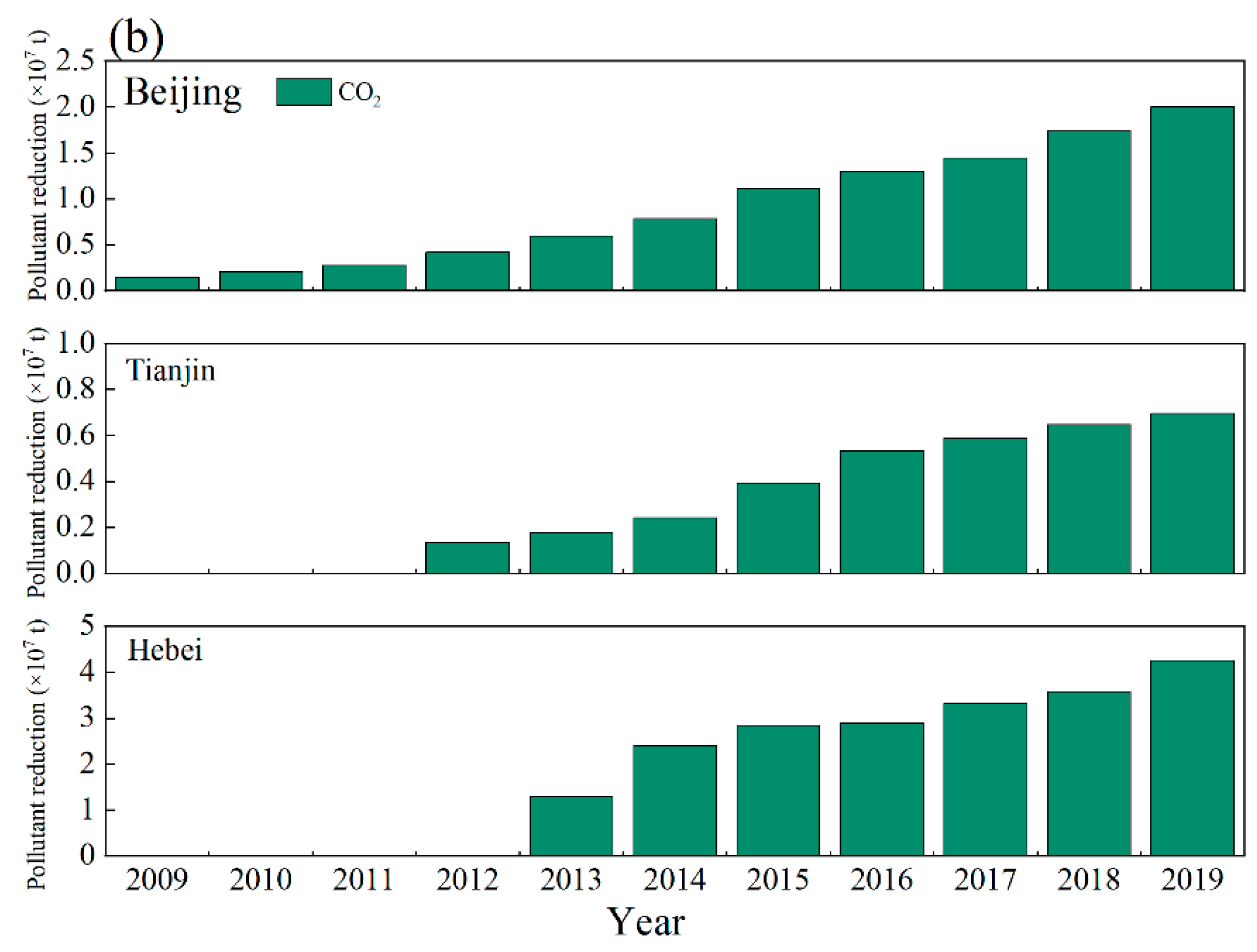


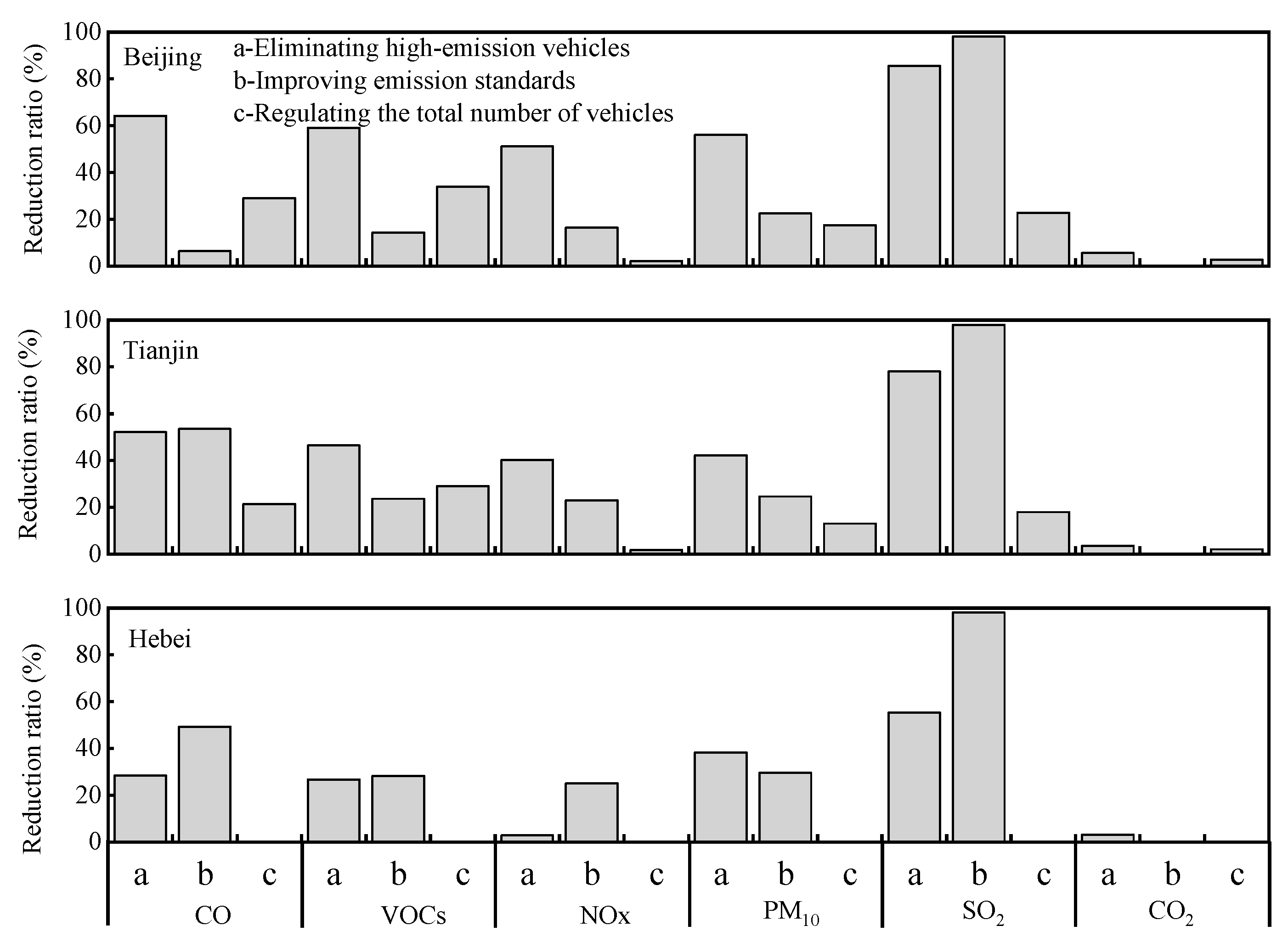
| Region | Type of Vehicle | China I | China II | China III | China IV | China V |
|---|---|---|---|---|---|---|
| Beijing | PC, LDV | 1999 | 2003 | 2006 | 2008 | 2013 |
| HDT, Bus | 2000 | 2003 | 2006 | 2013 | 2015 | |
| Tianjin | PC, LDV | 2000 | 2005 | 2008 | 2011 | 2015 |
| HDT, Bus | 2001 | 2004 | 2008 | 2013 | 2017 | |
| Hebei | PC, LDV | 2000 | 2005 | 2008 | 2011 | 2016 |
| HDT, Bus | 2001 | 2004 | 2008 | 2013 | 2017 |
Publisher’s Note: MDPI stays neutral with regard to jurisdictional claims in published maps and institutional affiliations. |
© 2022 by the authors. Licensee MDPI, Basel, Switzerland. This article is an open access article distributed under the terms and conditions of the Creative Commons Attribution (CC BY) license (https://creativecommons.org/licenses/by/4.0/).
Share and Cite
Yang, N.; Yang, L.; Xu, F.; Han, X.; Liu, B.; Zheng, N.; Li, Y.; Bai, Y.; Li, L.; Wang, J. Vehicle Emission Changes in China under Different Control Measures over Past Two Decades. Sustainability 2022, 14, 16367. https://doi.org/10.3390/su142416367
Yang N, Yang L, Xu F, Han X, Liu B, Zheng N, Li Y, Bai Y, Li L, Wang J. Vehicle Emission Changes in China under Different Control Measures over Past Two Decades. Sustainability. 2022; 14(24):16367. https://doi.org/10.3390/su142416367
Chicago/Turabian StyleYang, Ning, Lei Yang, Feng Xu, Xue Han, Bin Liu, Naiyuan Zheng, Yuan Li, Yu Bai, Liwei Li, and Jiguang Wang. 2022. "Vehicle Emission Changes in China under Different Control Measures over Past Two Decades" Sustainability 14, no. 24: 16367. https://doi.org/10.3390/su142416367
APA StyleYang, N., Yang, L., Xu, F., Han, X., Liu, B., Zheng, N., Li, Y., Bai, Y., Li, L., & Wang, J. (2022). Vehicle Emission Changes in China under Different Control Measures over Past Two Decades. Sustainability, 14(24), 16367. https://doi.org/10.3390/su142416367





